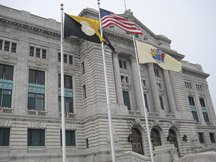As Joni Mitchell famously sang, “They paved paradise and put up a parking lot.” Shockingly, that’s almost what happened to Hudson County’s stately Justice William Brennan Court House in the 1960s, a decade of architectural ephemera that saw the demolition of the venerable Madison Square Garden in New York in 1966. That travesty gave rise to the modern preservationist movement. Both buildings were built in 1910.
“They were considered the finest muralists of their time.” – Meredith Lippman
________
Two panel discussions, presented by the Hudson County Office of Cultural & Heritage Affairs/Tourism Development, were held over the past two weeks to honor the centennial of the courthouse. Topics included the power of civic activism, the building’s beau-arts architecture, and its museum-quality murals.
From dilapidated to distinguished
Panelist John Gomez, M.S. Historic Preservation, Columbia University, is better known around town as a local historian and go-to guy for all things historic.
“I discussed the building’s long preservation journey from 1966, when it was abandoned and not even worth a dollar to the municipality, to 1985, when it was rededicated as a temple of law,” he said.
Instead of demolishing the building, they spent 20 years preserving it until it was worthy of inclusion on the National and New Jersey Registers of Historic Places.
Meredith Lippman, program development specialist for the Office of Cultural and Heritage Affairs, said that Gomez “presented a full and rounded picture of what was going on in the ’60s and ’70s that made it okay to tear down a building.”
For one thing, there were no national historic preservation laws on the books. But by “1970 the building had been put on the national register of historic sites due to the activity of certain citizens,” Lippman said.
One of those citizens was Theodore (Ted) Conrad, an architectural model maker for whom the rotunda is named.
Step inside
Though anyone walking along that stretch of Newark Avenue can’t help but admire the building on the outside, there is much to see on in the inside as well, especially its “museum-quality” murals.
“We brought together four women scholars who have written dissertations and books on the muralists,” Lippman said. “They were considered the finest muralists of their time.”
Completed in 1911, “the murals depict a sense of national history and pride and also some very specific events and people in this particular area,” Lippman said.
Among those depicting local events are two by Charles Yardley Turner, “General Washington at Fort Lee,” on the east wall of the fourth floor and “First Passage of the Steamer Clermont” on the west wall. Lippman pointed out that the people depicted in the western mural are facing west and those in the eastern mural facing east.
“There are also classical images that relate to law and justice,” Lippman said, “as would befit a building built as a ‘cathedral to justice.’”
The Office of Cultural and Heritage Affairs provides brochures for self guided tours of the building. Visit www.visithudson.org.
“The more people who come in and know the building and feel comfortable in it and recognize its national stature,” Lippman said, “the more they will treasure and value what is here in their midst.”
Kate Rounds can be reached at krounds@hudsonreporter.com..
The panels were funded by a grant from the Department of State/New Jersey Historical Commission (NJHC) and by Thomas A. DeGise, Hudson County Executive, the Hudson County Board of Chosen Freeholders and the Hudson County Office of Cultural & Heritage Affairs/Tourism Development.
